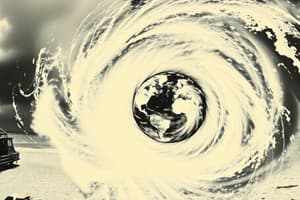Podcast
Questions and Answers
What is the primary mechanism that drives surface ocean currents?
What is the primary mechanism that drives surface ocean currents?
- Coriolis effect on deep water movements
- Density differences due to temperature and salinity
- Wind forces acting on the surface of the ocean (correct)
- Gravitational pull of the moon on ocean tides
What is the effect of the Ekman spiral on surface ocean currents in the Northern Hemisphere?
What is the effect of the Ekman spiral on surface ocean currents in the Northern Hemisphere?
- Surface currents do not move at all due to the Coriolis effect
- Surface currents move directly with the prevailing wind direction
- Surface currents move at a 90° angle to the left of the wind direction
- Surface currents move at a 90° angle to the right of the wind direction (correct)
Which term is used to describe the boundary between the low-density surface ocean and the higher-density deep ocean?
Which term is used to describe the boundary between the low-density surface ocean and the higher-density deep ocean?
- Thermocline
- Pycnocline (correct)
- Salycline
- Halocline
What phenomenon occurs at a depth of approximately 1 kilometer in the ocean relative to the wind effects?
What phenomenon occurs at a depth of approximately 1 kilometer in the ocean relative to the wind effects?
What type of ocean current is the Gulf Stream categorized as?
What type of ocean current is the Gulf Stream categorized as?
How do warm core eddies affect coastal regions like New England?
How do warm core eddies affect coastal regions like New England?
What are gyres in the context of oceanic currents?
What are gyres in the context of oceanic currents?
Which factor is NOT a primary influence on seawater density?
Which factor is NOT a primary influence on seawater density?
What is the primary effect of the orographic effect on precipitation patterns?
What is the primary effect of the orographic effect on precipitation patterns?
How does temperature influence the amount of water vapor air can hold?
How does temperature influence the amount of water vapor air can hold?
What atmospheric phenomenon is associated with low-pressure areas?
What atmospheric phenomenon is associated with low-pressure areas?
Which statement accurately describes a monsoon?
Which statement accurately describes a monsoon?
What role does ocean temperature play in the formation of hurricanes?
What role does ocean temperature play in the formation of hurricanes?
During which period is hurricane frequency at its peak in the North Atlantic?
During which period is hurricane frequency at its peak in the North Atlantic?
What initial conditions are necessary for the formation of a hurricane?
What initial conditions are necessary for the formation of a hurricane?
Which statement best defines the Coriolis effect as it relates to storm rotation?
Which statement best defines the Coriolis effect as it relates to storm rotation?
How do hurricanes form in terms of atmospheric pressure?
How do hurricanes form in terms of atmospheric pressure?
What is the primary reason hurricanes in the Northern Hemisphere rotate counterclockwise?
What is the primary reason hurricanes in the Northern Hemisphere rotate counterclockwise?
What is the significance of the eye in a hurricane?
What is the significance of the eye in a hurricane?
What primarily causes storm surge in hurricanes?
What primarily causes storm surge in hurricanes?
What effect does the trade wind zone have on hurricane tracking?
What effect does the trade wind zone have on hurricane tracking?
From where do the most dangerous winds associated with a hurricane arise?
From where do the most dangerous winds associated with a hurricane arise?
What indicates the category of a hurricane on the Saffir-Simpson Scale?
What indicates the category of a hurricane on the Saffir-Simpson Scale?
Why is there a Tropical Cyclone free zone near the equator?
Why is there a Tropical Cyclone free zone near the equator?
Flashcards are hidden until you start studying
Study Notes
Orographic Effect
- Prevailing winds force air over topographic barriers.
- Windward sides receive significant rainfall due to forced air uplift and cooling.
- Leeward sides experience dry conditions as sinking air absorbs soil moisture, creating deserts.
Atmospheric Circulation and Precipitation
- Warm air holds more water vapor than cool air.
- As air cools, water vapor condenses, leading to precipitation when humidity reaches 100%.
- Deserts typically form between 30°N and S, and beneath the ITCZ (Intertropical Convergence Zone) due to dry air sinking and absorbing moisture.
- Rainforests occur beneath the ITCZ, where warm, moist air rises, cools, and causes precipitation.
Atmospheric Pressure and Wind
- Atmospheric pressure measures the weight of the column of overlying air.
- High pressure is associated with cool, dense air sinking, generally leading to good weather.
- Low pressure indicates less dense, warm, moist air rising, often accompanied by rain or stormy weather.
- Really low pressure is linked to hurricanes.
- Isobars on weather maps connect areas of equal pressure.
- Wind flows from high pressure areas to low pressure areas.
- Wind speed increases with closer spacing of isobars.
Sea Breeze and Monsoon
- Sea breeze: Land heats up during the day, causing air to rise. Wind blows from the ocean inwards, creating a circulation cell. The direction reverses at night as land cools faster than the ocean.
- Monsoon: Larger-scale version of sea breeze. Land warms significantly in summer compared to the ocean, resulting in wind blowing from the ocean. If the wind rises over a topographic barrier, significant rainfall occurs in spring/summer.
Hurricanes
- Hurricanes are fueled by warm ocean water above 26°C (79°F).
- The North Atlantic has experienced anomalous warming in recent years, leading to stronger hurricanes.
- Hurricane frequency peaks in early September when ocean temperatures in the North Atlantic reach their seasonal maximum.
- Hurricanes originate as areas of low pressure off the West African coast, moving westward with trade winds.
- Hurricanes are called Typhoons in the Pacific and “Tropical Cyclones” in the Indian Ocean.
- Northern Hemisphere hurricanes rotate counterclockwise due to Coriolis effect causing wind deflection to the right as it approaches a low pressure system.
- The eye of the hurricane forms where rising air from all directions converges. Strongest winds occur at the eyewall, with no wind in the eye itself.
- The Coriolis effect causes the hurricane track to bend to the right and northward, eventually moving northeastward with westerly winds.
- There's a tropical cyclone-free zone near the equator due to the absence of the Coriolis effect.
- Hurricane hazards include high winds, intense rainfall, and storm surge. Flooding caused by storm surge is historically the most damaging.
- The Saffir-Simpson Scale categorizes hurricanes based on wind speed, with Category 5 being the most intense.
- Storm surge is caused by the “mounding” of seawater under low atmospheric pressure (pressure surge) and wind pushing water onshore (wind-driven surge).
- The “right, front” quadrant of a hurricane is the most dangerous due to the combined effect of rotating wind and the storm's forward motion.
Ocean Density and Circulation
- The thermocline represents the boundary between the low-density surface ocean and the high-density deep ocean.
- Seawater density is influenced by salinity and temperature.
- The pycnocline marks the boundary between the low-density surface ocean and the high-density deep ocean.
- Surface ocean currents are primarily driven by wind, while deep currents are driven by density (thermohaline circulation).
- The Ekman spiral describes the spiraling motion of water with depth, driven by wind. Surface currents are deflected 90° to the right (northern hemisphere) of the wind direction due to the Coriolis effect.
- The Gulf Stream is a well-known surface ocean current.
- Eddies form in areas where surface currents change direction sharply. Warm core rings bring warm water northward.
Gyres
- Gyres are large-scale systems of ocean surface currents, with 5 major gyres (plus the Antarctic Circumpolar Current).
- Subtropical gyres form between trade winds and westerlies.
Studying That Suits You
Use AI to generate personalized quizzes and flashcards to suit your learning preferences.




